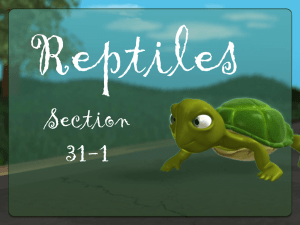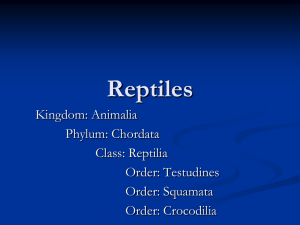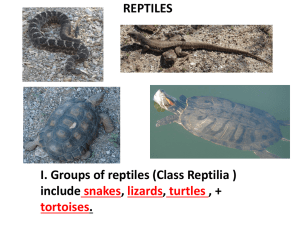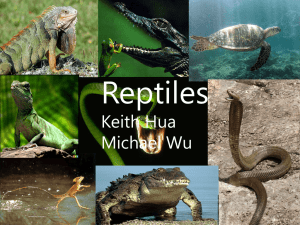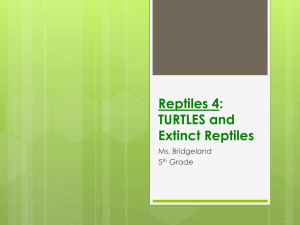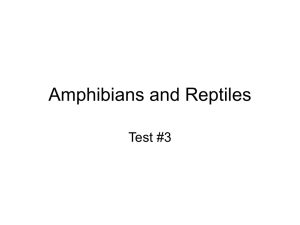04A Reptile Pets LP - Educational Excellence
advertisement
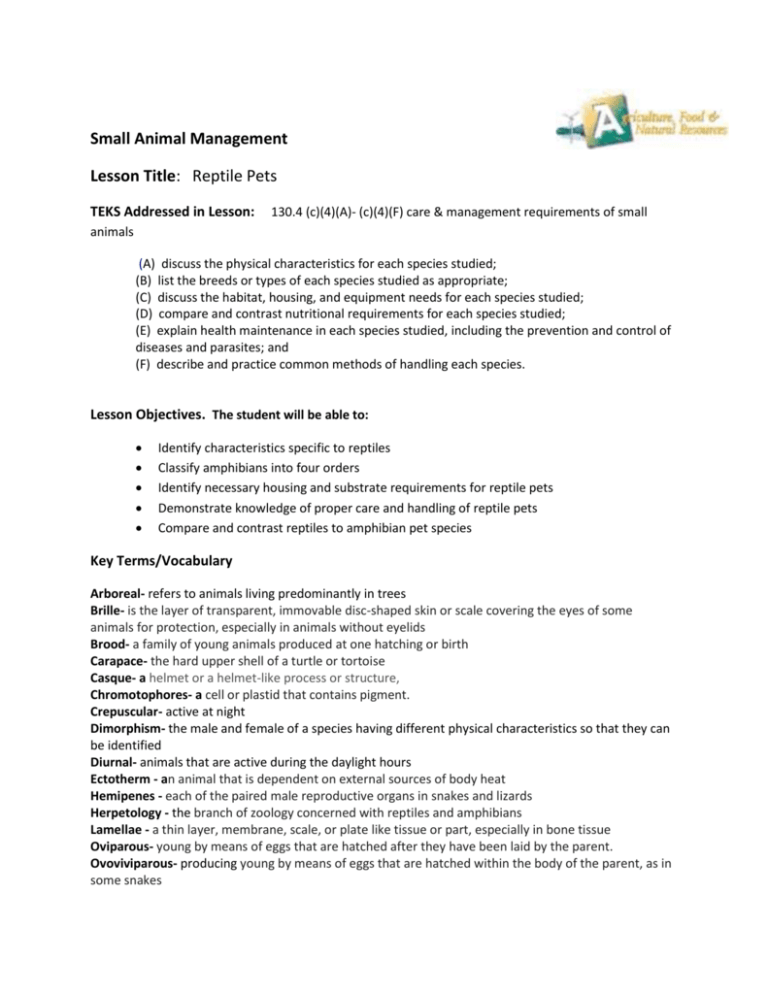
Small Animal Management Lesson Title: Reptile Pets TEKS Addressed in Lesson: 130.4 (c)(4)(A)- (c)(4)(F) care & management requirements of small animals (A) discuss the physical characteristics for each species studied; (B) list the breeds or types of each species studied as appropriate; (C) discuss the habitat, housing, and equipment needs for each species studied; (D) compare and contrast nutritional requirements for each species studied; (E) explain health maintenance in each species studied, including the prevention and control of diseases and parasites; and (F) describe and practice common methods of handling each species. Lesson Objectives. The student will be able to: Identify characteristics specific to reptiles Classify amphibians into four orders Identify necessary housing and substrate requirements for reptile pets Demonstrate knowledge of proper care and handling of reptile pets Compare and contrast reptiles to amphibian pet species Key Terms/Vocabulary Arboreal- refers to animals living predominantly in trees Brille- is the layer of transparent, immovable disc-shaped skin or scale covering the eyes of some animals for protection, especially in animals without eyelids Brood- a family of young animals produced at one hatching or birth Carapace- the hard upper shell of a turtle or tortoise Casque- a helmet or a helmet-like process or structure, Chromotophores- a cell or plastid that contains pigment. Crepuscular- active at night Dimorphism- the male and female of a species having different physical characteristics so that they can be identified Diurnal- animals that are active during the daylight hours Ectotherm - an animal that is dependent on external sources of body heat Hemipenes - each of the paired male reproductive organs in snakes and lizards Herpetology - the branch of zoology concerned with reptiles and amphibians Lamellae - a thin layer, membrane, scale, or plate like tissue or part, especially in bone tissue Oviparous- young by means of eggs that are hatched after they have been laid by the parent. Ovoviviparous- producing young by means of eggs that are hatched within the body of the parent, as in some snakes Plastron - the ventral surface of the turtle/tortoise shell Probing- a method used to determine the sex of adult snakes where a probe is inserted into the vent. The probe will travel deeper into a male than a female. Scutes- a thickened horny or bony plate on a turtle's shell or on the back of a crocodiles, tortoises and terrapins, etc Terrapin- a freshwater turtle, especially one of the smaller kinds of the Old World Terrarium-a cage used for keeping land animals Tortoise- a turtle, typically a herbivorous one that lives on land Tympanum- a membrane that picks up vibrations and transfers them to the inner ear Viviparous- animals that retain the young within their bodies in a preplacenta sac Substrate- the surface or material on or from which an organism lives, grows, or obtains its nourishment. Interest Approach/Anticipatory Set Have students use the website below to explore interesting facts about reptiles. http://www.herpsofnc.org/Myths/Herp_Facts.html Ask students for examples of reptiles. Then ask them to compare amphibians to reptiles. Can they list the differences? Show examples of the skin of a lizard or snake vs the skin of amphibians. Ask students to guess why the skin of these two species differs. What about eggs…show students pictures of eggs laid by a reptile and a female? Why are they different? Some of the examples include: texture of the skin, where they live and how fertilization and development occurs. Teaching Plan and Strategy Presentation of New Material Teacher PowerPoint that includes the following information: Characteristics To be considered a reptile, the following characteristics must be present: Reptiles have the following distinctive characteristics that put them in the class of reptiles: Reptiles have backbone and spines i.e. they are vertebrates. Reptiles have scales on their bodies and have a dry skin. Reptiles are cold blooded animals. Reptiles lay eggs. Reptiles have lungs and need air to breathe. Reptiles either have four legs or have no legs at all. Reptiles have ear holes instead of ears. There are approximately 6500 species of reptiles belonging to four different orders: 1. Testudines (Chelonia) a. Turtles b. Tortoises c. Terrapins 2. Serpentes a. Snakes b. Pythons c. Boas 3. Squamata a. Iguanas b. Lizards 4. Crocodilian a. crocodiles, b. alligators c. caimans d. gharials Hibernation Reptiles live in temperate zones and must hibernate during the winter: winter temperatures are too cold for them to remain active. The length of the hibernation period varies depending on how long the cold weather lasts. During hibernation, the reptiles body temperature drops to a oint wher the sytems barely function. Respiration and heartbeat are greatly reduced, and oxygen is absorbed through the skin. Hibernation is associated with brining the reptile into breeding condition; temperate-zone reptiles that are not allowed to hibernate do not breed. Housing and Equipment Reptiles can be kept in a terrarium, vivarium or aquarium. Four Types: 1. terrestrial habitats for reptiles that live on land 2. semi aquatic habitats for reptiles that live on land or in trees but spend part of their time in water 3. aquatic habitats for reptiles that live primarily in the water 4. arboreal habitats for reptiles that live in trees Care should be taken to make sure you provide enough room for growth depending upon each species. All housing facilities should have a lid/cover with holes for ventilation. Water should be changed ever 3-7 days to prevent the buildup of bacteria and harmful waste. Since reptiles are ectotherms and cannot generate their own body temperature, they take on the temperature of their environment. You must provide a heat source such as an incandescent light with a reflector shield. Basking rocks and pads can also be used with care. Sunlight is important but not only as a heat source, but also the skin absorbs the UV rays that are needed in calcium metabolism, formation of pigment, and vitamin D synthesis. Inadequate lighting can lead to metabolic bone disease and other issues. The lamps should not be place on top of a piece of glass because the glass with filter out UV rays. Appropriate substrate should be used depending upon the animal. Do your research and make sure you are changing the substrate often. Feeding Turtles Turtles and tortoises should be fed each day. Aquatic species are primarily carnivores or omnivores and will eat commercial pellets, leafy lettuce like romaine or spinach, raw fish, small goldfish, minnows or earthworms. Land turtles are usually herbivores and should be fed: alfalfa, clover, dark leafy greens, carrots, sweet potatoes, green beans, strawberries and cantaloupe. They should be fed a variety of foods to provide adequate nutrition. Snakes All snakes are carnivorous. Small snakes feed on small fish, earthworms, crickets and other insects. Medium sized snakes will each baby mice and rats. Larger snakes will feed on full grown mice, rats, baby chicks, guinea pigs, and rabbits. If feeding snakes live food such as rats and mice, you should observe the snake closely. If the snake does not eat the rodent within a few minutes, take it out. If left in the cage, it could inure the snake. Feeding killed prey is preferred for your safety and the snake’s safety. If they snake refuses to eat in a month or longer, it should be taken to a veterinarian. If the eyes cloud over, having a blue appearance, the snake is close to shedding and may not eat, Lizards Most lizards eat insects but can be fed flower blossoms, fresh fruit, vegetables, ground meat and dog or cat food. You should always research your particular lizard to discover proper diet requirements. Handling Turtles and similar species should be transported in a cardboard box. Turtles should be picked up by the shell with the fingers and thumb and placed on the hand. Care should be taken when handling snapping turtles; you should hold them far enough back to avoid being bit. Snakes that have not been handled often could be frightened and their reaction is to bite. Leather gloves can be worn the first few times you are handling the animal. You should grasp the snake firmly just behind the head. You should make sure you support both the head and the tail end of the snake at all times. The temperament of lizards varies greatly so some might become aggressive when handled. Lizards obtained at a young age can be worked with and will be comfortable with human interaction. Some will never want to be handled. When picking up a lizard, make sure you never pick it up from the tail, the tail liable to break as a defense mechanism and will grow back but without original coloration. Reproduction Turtles lay eggs (oviparous) that they deposit into a nest cavity in the soil. She will lay anywhere from 1 to 200 eggs. Soft shell eggs will hatch in about 30 days but the eggs of some land tortoises will take up to 18 months. Incubation depends on the temperature of the soil. When the young hatch, they are on their own for survival. Snakes are very interesting and varying creatures. They can be oviparous, ovoviviparous, or viviparous. Most are oviparous which means they lay eggs in shallow holes covered by soil or around large rocks or logs. Snakes that are ovoviviparous retain the eggs within their bodies until they hatch then they give birth to live young. The young receive no nourishment from the female; instead they get nourishment from the yolk of the egg. The garter snake is an example of an ovoviviparous snake. In some snakes, the young are retained in a placental sac within the female which allows for oxygen and nutrient exchange. Pit vipers are an example of a viviparous species. Lizards may be oviparous, ovoviviparous, or viviparous. The females will lay eggs in holes they dig. Incubation periods differ among species. Most have an egg tooth on their snout that allows them to crack the egg during hatching. During the brief period before mating, the males will turn a bright body color to attract the females. Activity/Application/Student Engagement/Laboratory 1) Teacher presentations that depict several examples of reptile species 2) Students create a presentation over one of the 4 orders. Presentation should include the following: o o o o o o History Classification 4 breeds/species Physical characteristics Housing requirements Breeding behavior o o o o Gestation/incubation Interesting facts Nutritional requirements Diseases/ailments 3) Have students use terrarium worksheet to create a terrarium for a reptile pet. The worksheet should be colored and labeled and must include all necessary elements for the pet (ie. Substrate, hide rock, temperature, basking stone, heat lamp, pool, etc…) References/Additional Materials/Extended Learning Opportunities/Enrichment Introduction to Veterinary Science, 2nd edition. Lawhead, J. , Baker, M.C. (2008) Thomson, Cengage Learning. Cahn, C. M., Line, S. (Eds.), 2005. The Merck Veterinary Manual, 10th edition. John Wiley & Sons Small Animal Management and Care, 3rd edition. Warren, Dean M. 2010. Delmar, Cengage Learning. Other Suggested Activities: Using the white boar, have students work together to create a flow chart of the scientific classification of reptiles. Using notes from class, divide the species of reptiles up between students. Have students create a facts sheet over their assigned species. Once complete, put all sheets together to make a scrapbook of reptile species for future reference or to post online. College and Career Readiness Standards: Science I. B1. (a-g) Design and conduct scientific investigations in which hypotheses are formulated and tested. III. C 1 (a-c) Presentation of scientific/technical information. V. D 1 (a-g) Understand that scientists categorize things according to similarities and differences. VI. E 1 (a-f) Know ways in which living things can be classified based on each organism’s internal and external structure, development, and relatedness of DNA sequences. Developed by the Department of Agricultural Leadership, Education & Communications, Texas A&M University for the Texas Education Agency, Educational Excellence Project for AFNR ©Texas Education Agency, 2014

